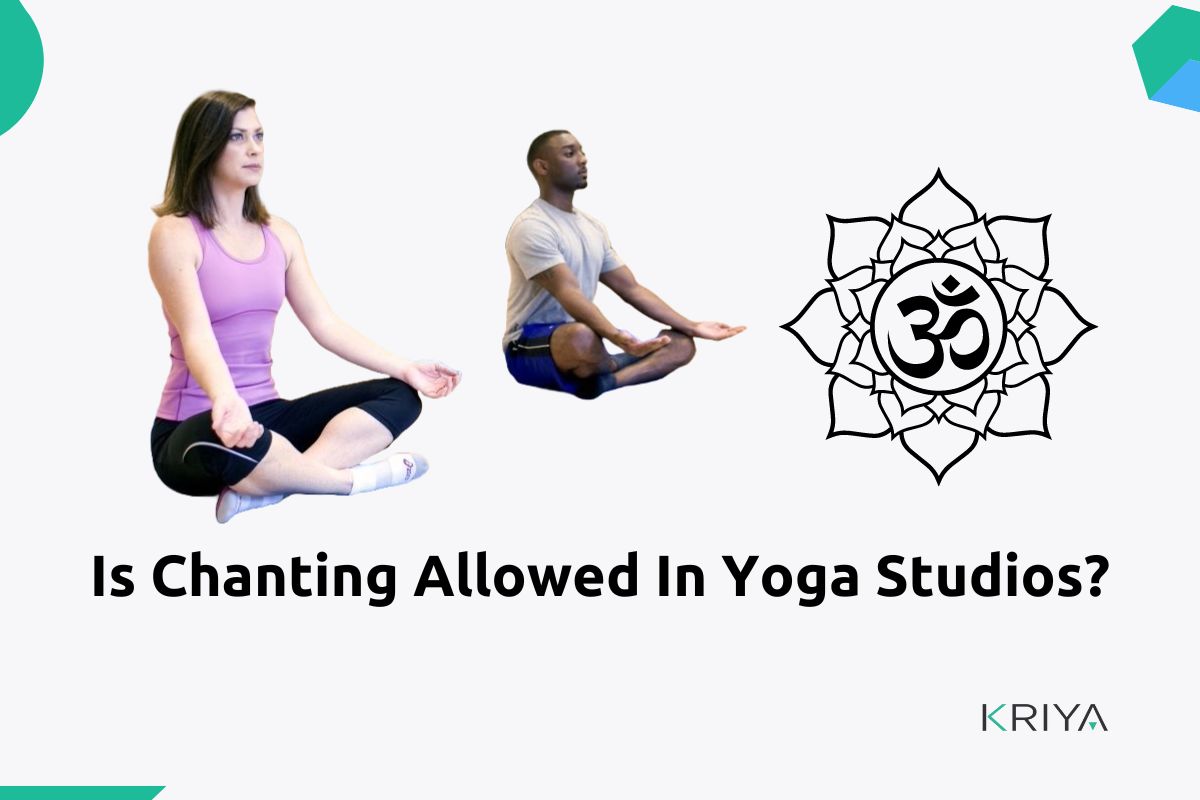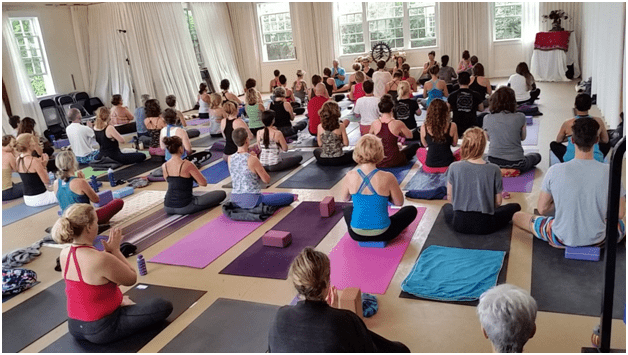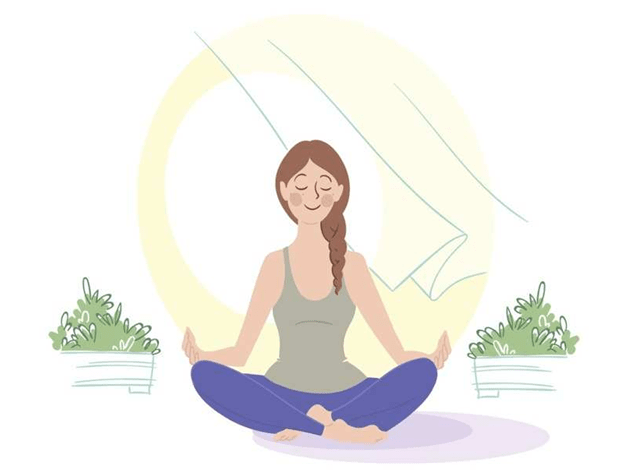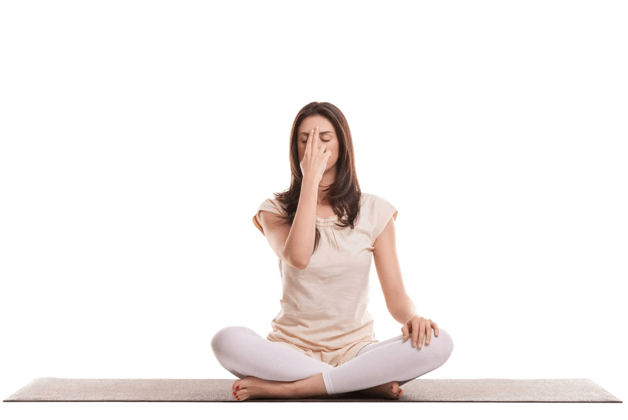
Is Chanting Allowed In Yoga Studios?
“I want to sing like the birds, not caring who listens or what they think.”- Rumi
Chanting is allowed in yoga studios but is not a necessary part of yoga.
Though Coronavirus is said to be over but still, if you are sick and have the flu or a cold, it is best to avoid chanting.
I love to chant many types of mantras. Many of my friends ask me why to chant mantras or do chanting at a yoga class. Well, the simple answer is to:
- Create a peaceful atmosphere because chants are divine
- Building confidence in yourself as a mantra boosts energy
- Chanting has the ability to get you completely rooted in your body and mind.
- Connect within yourself
My favourite mantras are:
Gayatri Mantra:
“Om bhur bhuvas svaha
Thath savithur varaynyam
Bhargo dheyvasya dhimahih
Dhyoyonah pratchodhay-yath”
Vishnu Mantra:
“Om Namho Bhagwatey Vasudevaya”
And
Durga Mantra:
“Sarva Mangala Mangalye Sive Sarvartha Sadhike
Saranye Trayambike Gauri Narayani Namostute”
Be it a simple OM Mantra or any type of chanting allowed in yoga studios of mantras in Sanskrit, Gurmukhi, Hindi, or English, its main purpose is to calm the mind and is used in meditation to attain the ultimate bliss and inner peace.
Table of Contents
Chanting Allowed In Yoga Studios
Chanting allowed in yoga studios is speaking out loud mantras that can be heard or speaking internally. Therefore, chanting allowed in yoga studios is helpful during your yoga and meditation practices. Keeping your mind focused on your breath and chanting in yoga studios during practice can help reduce the stress of the mind and make you more focused.
Chanting in Yoga Studios – Healthy Approach

Chanting in yoga studios if you have flu-like symptoms
Singing produces a particularly high level of respiratory particles (aerosols), which could potentially contain coronavirus.
If a singer is infected, they risk infecting others in the room via the air they breathe, especially since singing involves people inhaling deeply.
- Suppose you have a yoga studio that only practices meditation. In that case, you need chanting in yoga studios. This can be done by maintaining social distancing, where only five or six students can practice it, each six feet apart, with windows open.
- When you don’t offer meditation classes, you can avoid chanting in yoga studios for now.
- For Pranayams, only a short and simple chant of OM with a few students maintaining distance can be performed with open windows.
- As a teacher, only you can solo chant, and students can hear.
- Use an Audiotape of chants for students to focus on their minds
- Shun chanting for now if you feel you are not well.
Chanting in yoga studios is not necessary for every class.
Proper Ventilation is Essential

Air quality expert Lidia Morawska, from the Queensland University of Technology, has published on the Skagit Valley Chorale outbreak and says poor ventilation was a key factor in preventing aerosols from dissipating.
Professor Morawska says in addition to vaccination, singers need to improve ventilation and keep their distance from each other.
Proper air circulation is essential for maintaining a comfortable and healthy indoor environment.
Chanting Om

- When you say OM as a chant, you inhale slowly and deeply through both nostrils. On the exhale, chant the sound of the three-part OM mantra.
- In the OM chant, you open your mouth wide to start the “Ahh” sound at the back of your mouth. As the sound spreads and resonates through your mouth, throat, and chest, it transitions to a powerful “ooh” sound throughout your body.
- Finally, toward the end of your exhalation, you close your lips and press your tongue to the roof of your mouth, creating the “mmm” sound. Then, you must pause at the very end of your breath and take a slow, long inhale.
This means all breathing techniques can be performed without chanting loudly.
Best Alternatives
Many Yoga teachers practice breathing exercises in class instead of chanting. Before considering alternatives to chanting in yoga studios, you need to understand the process of chanting.
There are many ways to create a sense of unity in your yoga classroom without chanting in yoga studios or making new students uncomfortable. Many Yoga teachers practice class breathing exercises instead of chanting, and the easy one is to take three breaths together at the start and end of your yoga class.
Instead of chanting in yoga studios, ask your students to sit at a distance apart, take three deep inhales and audibly exhale together. This will give you a sense of connection with everyone in the room, a feeling of calm and presence in the body and mind, also in a way that is safer for everyone.
The other alternative to chanting in yoga studios is “Nadi Shodhana Pranayama.” Here, you must perform alternate nostril breathing or a subtle energy-clearing breathing technique. This type of breathwork can be done as part of a yoga or meditation practice or as a separate practice to help you quiet and still your mind.
How to do Nadi Shodhana Pranayama?

- You sit in a comfortable position as you sit while doing your chants. Place your left hand on your left knee.
- Lift your right hand toward your nose. Exhale completely and then use your right thumb to close your right nostril.
- Inhale through your left nostril and then close the left nostril with your fingers.
- Open the right nostril and exhale through this side. Inhale through the right nostril and then close this nostril.
- Open the left nostril and exhale through the left side.
This completes one cycle of this exercise. You can continue for up to 5 minutes. Complete the practice by finishing with an exhale on the left side.
Alternate nostril breathing may help you relax or clear your mind as you feel chanting.
As said above, the main idea of chanting is to connect with yourself, and these alternatives also serve that purpose.
If you are taking a meditation class where chanting in yoga studios is necessary, then the best alternative is to hear chants rather than speak them out because sound heals the body and relaxes the nervous system.

- In the Hindu or Sanskrit tradition, sound vibration is known as Nada.
- In the practice of Nada Yoga, the sound is used not only to restore physical and mental well-being but also as a path to spiritual awakening.
- Nada Yoga divides sound into external, Ahata, and internal sounds, Anahata.
- External sounds are perceived through the ears, and Nada Yoga can be as simple as listening to non-vocal music and gently focusing on the individual notes.
- You can listen to the different notes, even the chirp of a bird or the wind through trees. The aim is to allow awareness to move inwards.
Internal sounds are perceived through the Anahata (heart) chakra. Each human body has its unique sound or vibration, which is sacred to that individual. By regulating the breath, turning the attention inwards, and closing the ears with the fingers, you can begin to listen in on your inner sound. Re-aligning with this sound balances your energetic body and ultimately reconnects you with your divine presence.
Live Streaming Chanting
The best alternative is to stream your yoga classes live or take online classes. In these, you can chant from home, and your students can follow along from their comfort zone without any risk of getting ill. It’s all legal and safe.
Click here to find some wonderful chants and playlists from Spotify
Conclusion
Chanting is allowed in Yoga Studios, and yoga classes can be performed even without chanting. If any of your students or yoga teachers have the flu or are sick, you need to see whether chanting can be performed.
You have to think of yourself and your students’ health and avoid taking any risks. It’s your duty as a yoga teacher or studio owner to think of the community, in fact, humanity as a whole, to protect each and every you from any such risk factor that can be harmful.
FAQs
Q1.Why should I avoid chanting when I’m sick?
When you’re sick, your body often fights off infection, and chanting can exacerbate symptoms such as coughing or sneezing, which can spread germs to others nearby.
Q2. Are there alternatives to chanting that can be practised when sick?
If you’re feeling unwell, you may consider participating in a yoga class without chanting and focusing more on gentle movements, breathing exercises, and meditation to support your well-being without risking the spread of illness.
Q3. Is it necessary to make students chant in yoga class?
No not at all necessary. You can involve students in chanting or simply performing yoga classes.
Q4. Why do some yoga studios incorporate chanting into their classes?
Chanting is often integrated into yoga classes to focus the mind, promote relaxation, and connect with a sense of spirituality or inner peace. It can also serve as a form of meditation and breathwork.
Q5. What should I do if chanting makes me uncomfortable during a yoga class?
If chanting makes you uncomfortable during a yoga class, it’s important to communicate your feelings with the instructor. They may be able to offer modifications or alternative practices that align better with your preferences and beliefs.
